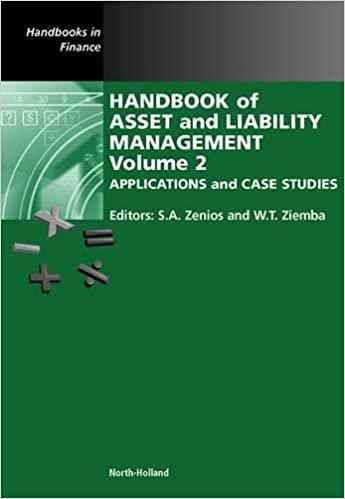Answered step by step
Verified Expert Solution
Question
1 Approved Answer
Chapter: 10 Problem: 23 Gardial Fisheries is considering two mutually exclusive investments. The projects' expected net cash flows are as follows: Expected Net Cash Flows
| Chapter: | 10 | ||||||||||||||
| Problem: | 23 | ||||||||||||||
| Gardial Fisheries is considering two mutually exclusive investments. The projects' expected net cash flows are as follows: | |||||||||||||||
| Expected Net Cash Flows | |||||||||||||||
| Time | Project A | Project B | |||||||||||||
| 0 | ($375) | ($575) | |||||||||||||
| 1 | ($300) | $190 | |||||||||||||
| 2 | ($200) | $190 | |||||||||||||
| 3 | ($100) | $190 | |||||||||||||
| 4 | $600 | $190 | |||||||||||||
| 5 | $600 | $190 | |||||||||||||
| 6 | $926 | $190 | |||||||||||||
| 7 | ($200) | $0 | |||||||||||||
| a. If each project's cost of capital is 11%, which project should be selected? If the cost of capital is 17%, what project is the proper choice? | |||||||||||||||
| @ 11% cost of capital | @ 17% cost of capital | ||||||||||||||
| Use Excel's NPV function as explained in this chapter's Tool Kit. Note that the range does not include the costs, which are added separately. | |||||||||||||||
| WACC = | 11% | WACC = | 17% | ||||||||||||
| NPV A = | NPV A = | ||||||||||||||
| NPV B = | NPV B = | ||||||||||||||
| b. Construct NPV profiles for Projects A and B. | |||||||||||||||
| Before we can graph the NPV profiles for these projects, we must create a data table of project NPVs relative to differing costs of capital. | |||||||||||||||
| Project A | Project B | ||||||||||||||
| 0% | |||||||||||||||
| 2% | |||||||||||||||
| 4% | | ||||||||||||||
| 6% | |||||||||||||||
| 8% | |||||||||||||||
| 10% | |||||||||||||||
| 12% | |||||||||||||||
| 14% | |||||||||||||||
| 16% | | ||||||||||||||
| 18% | |||||||||||||||
| 20% | |||||||||||||||
| 22% | |||||||||||||||
| 24% | |||||||||||||||
| 26% | |||||||||||||||
| 28% | | ||||||||||||||
| 30% | |||||||||||||||
| c. What is each project's IRR? | |||||||||||||||
| We find the internal rate of return with Excel's IRR function: | |||||||||||||||
| IRR A = | Note in the graph above that the X-axis intercepts are equal to the two projects' IRRs. | ||||||||||||||
| IRR B = | |||||||||||||||
| d. What is the crossover rate, and what is its significance? | |||||||||||||||
| Cash flow | |||||||||||||||
| Time | differential | ||||||||||||||
| 0 | |||||||||||||||
| 1 | |||||||||||||||
| 2 | Crossover rate = | ||||||||||||||
| 3 | |||||||||||||||
| 4 | The crossover rate represents the cost of capital at which the two projects' NPV is equal to: | ||||||||||||||
| 5 | |||||||||||||||
| 6 | |||||||||||||||
| 7 | |||||||||||||||
| e. What is each project's MIRR at a cost of capital of 11%? At r = 17%? Hint: note that B is a 6-year project. | |||||||||||||||
| @ 11% cost of capital | @ 17% cost of capital | ||||||||||||||
| MIRR A = | MIRR A = | ||||||||||||||
| MIRR B = | MIRR B = | ||||||||||||||
| f. What is the regular payback period for these two projects? | |||||||||||||||
| Project A | |||||||||||||||
| Time period | 0 | 1 | 2 | 3 | 4 | 5 | 6 | 7 | |||||||
| Cash flow | -375 | -300 | -200 | -100 | 600 | $600 | $926 | ($200) | |||||||
| Cumulative cash flow | |||||||||||||||
| Payback | |||||||||||||||
| Project B | |||||||||||||||
| Time period | 0 | 1 | 2 | 3 | 4 | 5 | 6 | 7 | |||||||
| Cash flow | -575 | 190 | 190 | 190 | 190 | $190 | $190 | $0 | |||||||
| Cumulative cash flow | |||||||||||||||
| Payback | |||||||||||||||
| g. At a cost of capital of 11%, what is the discounted payback period for these two projects? | |||||||||||||||
| WACC = | 11% | ||||||||||||||
| Project A | |||||||||||||||
| Time period | 0 | 1 | 2 | 3 | 4 | 5 | 6 | 7 | |||||||
| Cash flow | -375 | -300 | -200 | -100 | 600 | $600 | $926 | ($200) | |||||||
| Disc. cash flow | |||||||||||||||
| Disc. cum. cash flow | |||||||||||||||
| Discounted Payback | |||||||||||||||
| Project B | |||||||||||||||
| Time period | 0 | 1 | 2 | 3 | 4 | 5 | 6 | 7 | |||||||
| Cash flow | -575 | 190 | 190 | 190 | 190 | $190 | $190 | $0 | |||||||
| Disc. cash flow | |||||||||||||||
| Disc. cum. cash flow | |||||||||||||||
| Discounted Payback | |||||||||||||||
| h. What is the profitability index for each project if the cost of capital is 11%? | |||||||||||||||
| PV of future cash flows for A: | |||||||||||||||
| PI of A: | |||||||||||||||
| PV of future cash flows for B: | |||||||||||||||
| PI of B: | |||||||||||||||
Step by Step Solution
There are 3 Steps involved in it
Step: 1

Get Instant Access to Expert-Tailored Solutions
See step-by-step solutions with expert insights and AI powered tools for academic success
Step: 2

Step: 3

Ace Your Homework with AI
Get the answers you need in no time with our AI-driven, step-by-step assistance
Get Started


